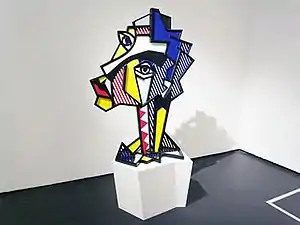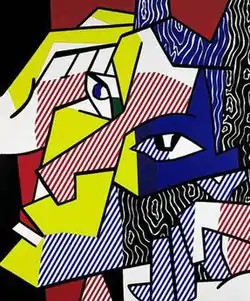| Expressionist Head | |
|---|---|
 | |
| Artist | Roy Lichtenstein |
| Year | 1980 |
| Type | Painted Bronze |
| Dimensions | 139.7 cm × 113.7 cm × 45.7 cm (55 in × 44.75 in × 18 in) |
| Location | six editions |
Expressionist Head by pop artist Roy Lichtenstein is the name associated with several 1980s works of art. It is widely associated with a set of six identical sculptures but is also associated with a series of paintings.
Sculptures
In the 1980s and 1990s, Lichtenstein created painted bronze sculptures that were based on his earlier paintings. Expressionist Head was among the earliest of these sculptural adaptations.[1] The sculpture is composed of painted and patinated bronze with painted wooden base.[2]
Expressionist Head reflects rootings of German Expressionist prints because of its "angular anatomies and bold contours", but Lichtenstein swapped out his characteristic Ben-Day dots with hatch marks to in his favored primary colors. Like many Lichtenstein sculptures, this set is essentially two-dimensional rather than volumetric.[3]
Lichtenstein replaced Ben-Day dots with stripes in some of his sketches because it was more efficient. Stripes did not become common in his finished goods until he began working with sculptures. In Expressionist Head, stripes accentuate the sculpture's linear aspects.[4] Like almost all 20 of his sculptures produced up to 1980, this "...began as a line drawing, in elevation; proceeded to full-scale blacktape layout; and then to a magna-painted, handcrafted wooden maquette, which established the mold for the casting...in bronze by lost-wax process."[5]
Paintings
| Expressionist Head | |
|---|---|
 | |
| Artist | Roy Lichtenstein |
| Year | 1980 |
| Type | Pop art |
| Dimensions | 182 cm × 152 cm (72 in × 60 in) |
| Location | various |
One element of the painting series (pictured in infobox) was sold at Sotheby's on May 12, 2010 for $4,282,500.[6][7] In the subsequent months that element of the painting series was exhibited at the Nevada Museum of Art in a four-month single-painting exhibition.[8] There are five different paintings listed on the Lichtenstein Foundation website under the title Expressionist Head. Three are from 1980, while one each is from 1982 and 1984.[9] Another work by the same name had sold at Christie's, New York on November 18, 1997 for $ 300,000 USD.[10]
Critical commentary
The work is presented as feelingless as a statement of the detachment of many current forms of production and reproduction of works of art.[11]
See also
References
- ↑ Waldman, Diane (1993). Roy Lichtenstein. Solomon R. Guggenheim Museum. p. 327. ISBN 0-89207-108-7.
In the 1980s and '90s, he continued to make painted bronzes based on motifs from his paintings, expanding his range of subjects to include Expressionist Head (fig. 263), 1980...
- ↑ "Expressionist Head". Lichtenstein Foundation. Retrieved May 14, 2012.
- ↑ Arnason, H. H., Daniel Wheeler (revising author third edition), and Marla F. Prather (revising author, fourth edition) (1998). "Pop Art and Europe's New Realism". History of Modern Art: Painting • Sculpture • Architecture • Photography (fourth ed.). Harry N. Abrams, Inc. pp. 538–540. ISBN 0-8109-3439-6.
Expressionist Head (fig. 632) recalls the angular anatomies and bold contours of German Expressionist prints (see fig. 152), but Lictenstein, himself an accomplished printmaker, regularized the forms within heavy black lines, using bright, primary colors and replacing the characteristic Benday dots with emphatic hatch marks. Like most of Lichtenstein's sculpture, Expressionist Head is essentially a two-dimensional conception, like a freestanding painting in relief, rather than a volumetric structure in the round.
{{cite book}}:|author=has generic name (help)CS1 maint: multiple names: authors list (link) - ↑ Hendrickson, Janis (1993). "A Closer Look At Benday Dots". Roy Lichtenstein. Benedikt Taschen. pp. 48–49. ISBN 3-8228-9633-0.
The stripes had already taken the place of dots in preliminary drawings, since they were quicker and easier to sketch. Yet the formal acceptance of stripes as a final form came about after Lichtenstein had worked on figurative sculpture that had grown directly out of his painted oeuvre. Although a piece like Standing Explosion (1965) works with perforated steel to show dots in a negative way, positive dots were impossible in sculpture since they could not float in free space. In his Cup and Saucer (Ill. p. 60) sculptures, his Expressionist Head or his Matissean Goldfish Bowl (Ill. p. 61) series, the shading effect of the diagonals emphasizes the linear quality of the sculpture as a whole.
- ↑ Cowart, Jack (1981). Lichtenstein: Roy Lichtenstein 1970–1980. Hudson Hills Press, Inc. p. 148. ISBN 0-933920-14-8.
- ↑ "Contemporary Art Evening Auction". Sotheby's. May 12, 2010. Retrieved May 11, 2012.
- ↑ "Catalogue Notes and Provenance". Sotheby's. May 12, 2010. Retrieved May 11, 2012.
- ↑ "Roy Lichtenstein: Expressionist Head". Nevada Museum of Art. Archived from the original on November 5, 2011. Retrieved May 11, 2012.
- ↑ "String: Expressionist Head". Lichtenstein Foundation. Retrieved May 14, 2012.
- ↑ "Roy Lichtenstein (American, 1923 - 1997): Expressionist head". Blouin Art Sales Index. Retrieved May 15, 2012.
- ↑ Foster, Hal (2009). "Pop Pygmalion". In Bader, Graham (ed.). Roy Lichtenstein: October Files. The MIT Press. p. 156. ISBN 978-0-262-51231-2.
...Expressionist Head (1980) appears drained of feeling, as if to suggest that, in our world not only of mechanical reproduction but also of electronic simulation, expression can only be coded, never immediate (the piece dates to the rise of Neo-Expressionism, which it comments on wryly as well).